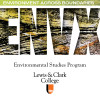Building a career without a blueprint

Recently, I have realized that I am no longer a recent graduate. With each passing year, graduation is a little farther away, yet the lessons I learned in school are still at my fingertips as I pursue a career in nonprofit ecological stewardship.
If you asked me on May 10, 2014 where I was going, all I could say was “I have no idea”. Which was scary because for the first time in my life, I didn’t have a plan. What I did have was a passion for problem solving. I had managed to go overseas twice, studying abroad in Swaziland and working for a summer in Guangzhou, China. And, despite an initial disinterest in social sciences, I had completed an interdisciplinary degree in Environmental Studies and Biology.
The summer after graduation, I juggled part-time jobs, one of which was in development at a small environmental media nonprofit. That role introduced me to ecological stewardship volunteer opportunities that led me to do a yearlong term with the Golden Gate National Parks Conservancy in San Francisco, CA. That role prepared me for an opportunity restoring coastal dune habitat in San Diego, which in turn prepared me to be a role in the Stewardship Program at the Mountains to Sound Greenway Trust in Seattle, WA, where I’ve been working for nearly two years. In my current role, I’ve built upon my previous work experience facilitating volunteer stewardship events, teaching students on field trips, and managing multi-faceted restoration projects.
From six years out, my early career tells a story of logically transitioning between roles to build complementary experiences in the conservation field. But my professional path has been more fortuitous than designed. What has guided me is my academic foundation in dissecting and digging into complex environmental problems. I use communication and cross-cultural understandings I developed as an undergraduate to listen more fully to diverse and conflicting perspectives to create a holistic picture of intersecting challenges. The breadth of my academic background allowed me to be flexible as I follow job opportunities.
While I have worked at some amazing environmental nonprofits, I have been haunted by another wicked problem. As a person of mixed-race descent, I am often one of few, sometimes the only, person of color on staff. I feel privileged to represent both cultures, however, as I continue working at environmental nonprofits, I am increasingly aware that my colleagues do not look like my family and that is not changing. These organizations share my passions and are committed to doing good work I care about, but the decision makers do not represent my whole heritage nor the larger society, with whom they are working to serve.
As I transition to no longer being able to qualify my career as “early”, I am happy to say I still do not have a plan. Currently, I am hoping to attend graduate school to pursue a Masters of Public Administration, adding policy and management skills to the education I received from Lewis & Clark. I am particularly focused on programs with Diversity, Equity, and Inclusion priorities in their core curricula. But, who knows where that will take me. And, even amid all the uncertainty, I’m hopeful for the future.
Environmental Studies is located in room 104 of Albany Quadrangle on the Undergraduate Campus.
MSC: 62
email envs@lclark.edu
voice 503-768-7790
Symposium Advisor Jim Proctor
Environmental Studies
Lewis & Clark
615 S. Palatine Hill Road
Portland OR 97219
More Stories

Farming, Oceanography, and the Arctic
Rylie Neely ’20 shares how she continued to use her ENVS education during an unplanned career pause due to Covid.
2025 Project Descriptions for the Rogers Program
Summer science research opportunities

Finding Paths
ENVS alum, Julian Brastow ’22, describes his initial job search after graduating from LC.

Place-Based Learning
From Trash to Treasure: Creating Art From Waste
Cara Tomlinson’s Art and Ecology class uses waste materials from around Portland to create beautiful and meaningful works of art. This course offers a fresh approach to creative practice, merging art and ecology to help students respond to the climate crisis, explore the agency of materials, and build connections to place.
